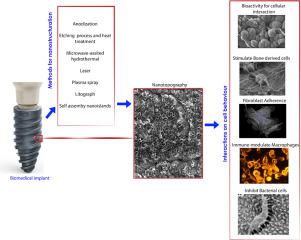Advances in Colloid and Interface Science ( IF 15.9 ) Pub Date : 2020-09-08 , DOI: 10.1016/j.cis.2020.102265 Marcel F Kunrath 1 , Fernando M Diz 2 , Ricardo Magini 3 , María E Galárraga-Vinueza 4

|
Nanostructured surfaces feature promising biological properties on biomaterials attracting large interest at basic research, implant industry development, and bioengineering applications. Thou, nanoscale interactions at a molecular and cellular level are not yet completely understood and its biological and clinical implications need to be further elucidated. As follows, the aim of this comprehensive review was to evaluate nanostructured surfaces at biomedical implants focusing on surface development, nanostructuration, and nanoengineered drug delivery systems that can induce specific cell interactions in all relevant aspects of biological, reparative, anti-bacterial, anti-inflammatory and clinical processes. The methods and the physio-chemical properties involved in nanotopography performance, the main cellular characteristics involved at surface/cell interaction, and a summary of results and outlooks reported in studies applying nanostructured surfaces and nano-drug delivery systems is presented. The future prospects and commercial translation of this developing field, particularly concerning multifunctional nanostructured surfaces and its clinical implications are further discussed. At a cellular level, nanostructured biomedical implant surfaces can enhance osteogenesis by targeting osteoblasts, osteocytes, and mesenchymal cells, stimulate fibroblast/epithelial cells proliferation and adherence, inhibit bacterial cell proliferation and biofilm accumulation, and act as immune-modulating surfaces targeting macrophages and reducing pro-inflammatory cytokine expression. Moreover, several methodological options to create drug-delivery systems on metallic implant surfaces are available, however, the clinical translation is yet incomplete. The efficiency of which nanostructured/nano-delivery surfaces may target specific cell interactions and favor clinical outcomes needs to be further elucidated in pre-clinical and clinical studies, along with engineering solutions for commercial translation and approval of controlling agencies.
中文翻译:

纳米相互作用:纳米结构和纳米药物输送生物医学植入物表面对细胞行为的深刻影响
纳米结构表面在生物材料上具有令人鼓舞的生物学特性,在基础研究,植入物行业发展和生物工程应用中引起了极大的兴趣。您,在分子和细胞水平上的纳米级相互作用尚不完全清楚,需要进一步阐明其生物学和临床意义。如下所述,本次全面综述的目的是评估生物医学植入物的纳米结构表面,重点是表面发育,纳米结构和纳米工程化的药物传递系统,这些系统可以在生物学,修复,抗菌,抗微生物的所有相关方面诱导特定的细胞相互作用。炎症和临床过程。纳米形貌性能涉及的方法和理化性质,介绍了涉及表面/细胞相互作用的主要细胞特征,并总结了应用纳米结构表面和纳米药物递送系统的研究结果和展望。进一步讨论了这个发展领域的未来前景和商业翻译,特别是关于多功能纳米结构表面及其临床意义。在细胞水平上,纳米结构的生物医学植入物表面可通过靶向成骨细胞,骨细胞和间充质细胞来增强成骨作用,刺激成纤维细胞/上皮细胞增殖和粘附,抑制细菌细胞增殖和生物膜积聚,并充当针对巨噬细胞和减少肿瘤细胞的免疫调节表面促炎细胞因子的表达。此外,在金属植入物表面上创建药物递送系统的几种方法可供选择,但是,临床翻译尚不完善。需要在临床前和临床研究中进一步阐明纳米结构/纳米传递表面可能针对特定细胞相互作用并有利于临床结果的效率,以及用于商业翻译和控制机构批准的工程解决方案。











































 京公网安备 11010802027423号
京公网安备 11010802027423号